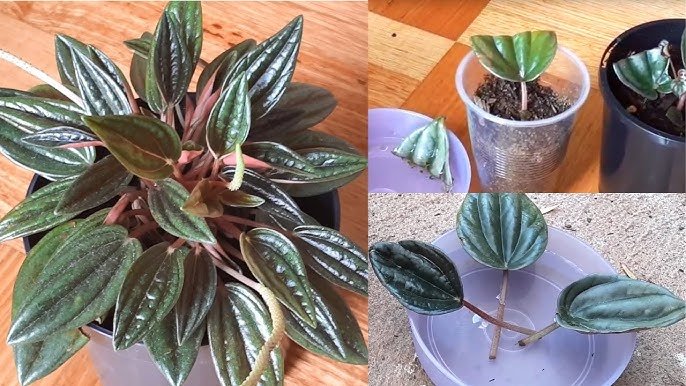Peperomia Plant Care: Tips For Thriving Houseplants In Your Home: Peperomias are cherished for their easy-care nature and diverse foliage, making them perfect for adding a touch of greenery to any home. Their compact size and tolerance of indoor conditions make them ideal houseplants, even for beginners. This article provides comprehensive tips on peperomia plant care, ensuring your peperomias thrive and enhance your living space.
Understanding Peperomia Plants
Peperomias are native to tropical and subtropical regions and belong to the Piperaceae family. They are known for their succulent-like leaves, which store water, making them relatively drought-tolerant. They are epiphytes, meaning they can grow on other plants or surfaces in the wild. Peperomias are generally slow-growing and compact, making them ideal for small spaces.
Choosing the Right Peperomia Variety
With a vast number of species available, selecting the right peperomia can be exciting. Some popular choices include:
- Peperomia obtusifolia (Baby Rubber Plant): Known for thick, glossy leaves and an upright growth habit.
- Peperomia argyreia (Watermelon Peperomia): Features leaves with silver and green stripes resembling a watermelon rind.
- Peperomia caperata (Emerald Ripple Peperomia): Displays deeply textured, heart-shaped leaves.
Essential Steps for Peperomia Plant Care

- Light Requirements:Peperomias thrive in bright, indirect light. They can tolerate low light conditions, but growth may slow. Avoid direct sunlight, as it can scorch the leaves. Position your peperomia in front of a west- or east-facing window or a few feet back from a south- or north-facing window. Insufficient light results in fewer leaves, leaf drop, and drab coloration.
- Watering:Allow the top 2 inches of soil to dry out between waterings. Peperomias are prone to root rot if overwatered. Water only when the soil is dry to the touch. Ensure all excess water drains out of the pot’s drainage holes. It’s always better to water peperomias less often rather than too much.
- Soil:Use a well-draining potting mix. A cactus or succulent mix is ideal. You can also lighten regular potting soil with coconut coir and perlite for good aeration. Peperomia plants prefer well-draining soil. This will help prevent root rot, which is often caused by poorly drained soils.
- Temperature:Peperomias thrive in temperatures between 18°C and 26°C. If you’re considering placing your Peperomia plants outdoors all year, make sure it’s USDA zone 10, since they cannot handle freezing temperatures. In cooler areas, move plants indoors before nighttime temperatures drop to 50°F. Keep them away from radiators.
- Humidity:Peperomias do well in medium-level humidity. They thrive in moderate humidity. If the air is too dry, consider misting the plant regularly or using a humidity tray. A bathroom or kitchen would be ideal, but they will thrive in other rooms if you mist regularly.
- Fertilizing:Peperomias do not require fertilization very often. Provide a diluted liquid fertilizer once a month during the growing season if the soil is poor. The growing season for the Peperomia obtusifolia is spring and summer. Do not fertilize in the winter.
- Potting and Repotting:Ensure your Peperomia plant’s pot is the right size (not too big) and has drainage holes to prevent excess water from accumulating. Most peperomia are slow-growing and will only need repotting every three to four years. Use a general, peat-free house plant compost, potting up your plant into a container one size bigger than its current pot.
- Pruning:They look their best when the leaves are bushy. Pinch out the tops of their stems to make plants bushier. Remove yellowed leaves or extra growth as necessary. Use a clean pair of scissors or snips to remove any dead foliage or yellowing leaves.
- Pest and Disease Management:Keep an eye out for common indoor pests such as spider mites, mealybugs, and scale insects. Treat promptly if you notice any signs of infestation.
- Air Circulation:Ensure good air circulation around your peperomia plant.
Also Read : How To Grow And Care For Peperomia Plants
Conclusion
Peperomia plants are a delightful addition to any home, offering beauty with minimal effort. By providing bright, indirect light, well-draining soil, proper watering techniques, and attention to humidity and temperature, you can ensure your peperomias thrive. Regular monitoring and occasional pruning will keep your peperomias healthy and vibrant, bringing a touch of the tropics to your indoor space.
FAQs
What kind of light do peperomias need?
Peperomias thrive in bright, indirect light, but should be protected from direct sunlight.
How often should peperomias be watered?
Allow the top 2 inches of soil to dry out between waterings to prevent root rot.
What is the best soil mix for peperomias?
A well-draining mix, such as a cactus or succulent mix, is ideal.
How often should peperomias be fertilized?
Fertilize monthly during the growing season (spring and summer) with a diluted liquid fertilizer.
How do I prevent root rot in peperomias?
Ensure proper drainage, use well-draining soil, and avoid overwatering.

